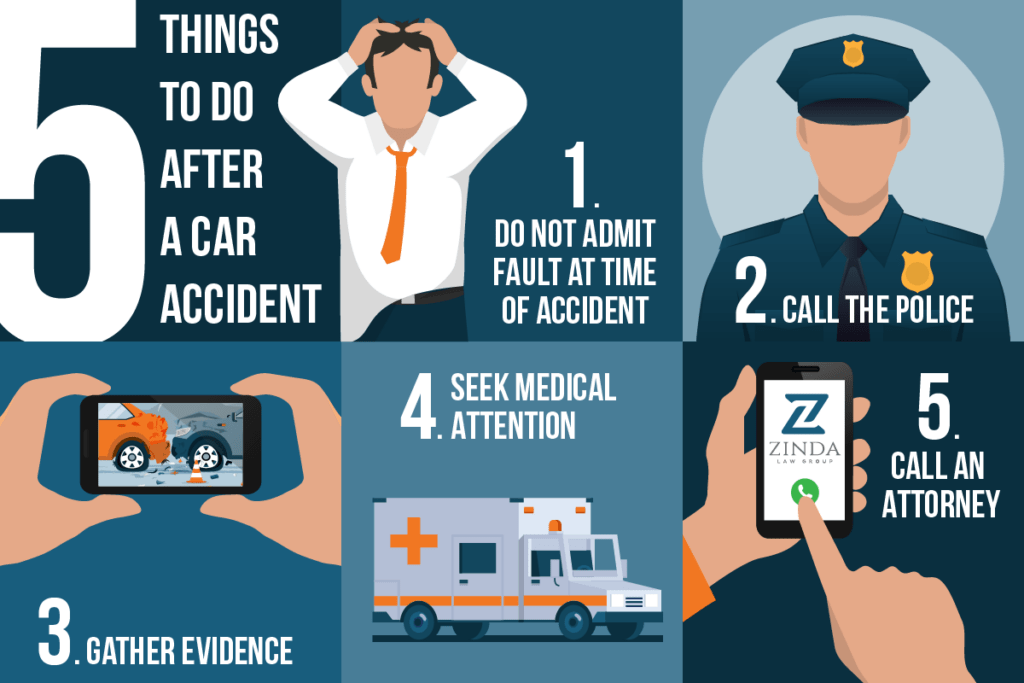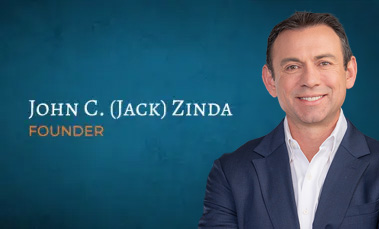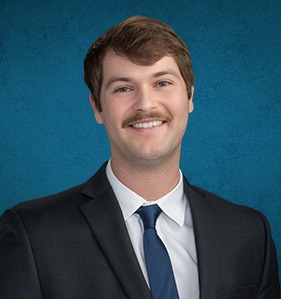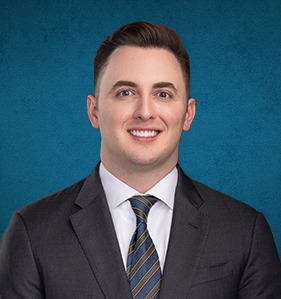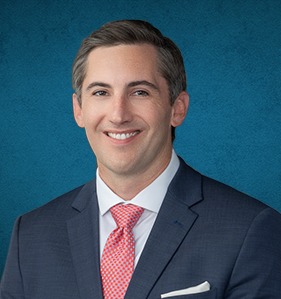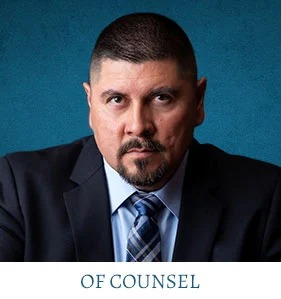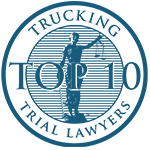Car accidents are not uncommon in Arizona. In recent statistics, there were approximately 121,345 motor vehicle accidents. Of these accidents, 1063 ended in fatalities. Even a minor car crash can be a major pain.
Nobody wants to deal with insurance companies, car repairs, and medical bills. Though you may be able to handle minor car accident claims on your own, a large-scale car accident claim may require the help of an experienced personal injury attorney.
The car accident lawyers of Zinda Law Group in Arizona can help. Our legal team can investigate the cause of your crash, identify all sources of liability, deal with the insurance adjusters, and fight to recover the maximum damages possible in your case.
 What to Do After a Car Accident in Arizona
What to Do After a Car Accident in Arizona
According to the 2021 Arizona Department of Transportation Motor Vehicle Crash Facts, car accidents in urban areas were more common than car accidents in rural areas, with 104,757 urban accidents and 16,588 rural accidents.
Among all the Arizona counties, Maricopa County was deemed to be the most dangerous to drive in. No matter where in the state you were injured, a car accident attorney can help walk you through the process from start to finish.
Seek Medical Attention
Seek a medical examination immediately after an accident. In many car accident cases, victims do not immediately feel the full extent of their injuries because of the adrenaline rush they experience after an accident.
Once a victim starts feeling pain and then decides to file a car accident claim, he or she may have a much more difficult uphill battle with an insurance company.
If a victim decides to file a claim against the driver responsible for their injuries once they start feeling pain, the driver’s insurance company may argue that the victim is lying or faking his or her injuries because the victim did not immediately go to the hospital to seek treatment.
To avoid this predicament, visit the doctor immediately after a car accident to protect your health and evidence of your injuries. Your Arizona car accident lawyer can help you gather these invoices and medical records if you are unable to obtain them right away.
Document the Accident
To prevail in a car accident, you have the burden of proof to show that the other driver was negligent. This simply means you must present evidence that the other driver was negligent. Evidence may include photographs, medical bills, and witness statements.
If you are able, document and retrieve evidence from the scene. The police will generally write a report detailing the crash, with information about the participants, insurance policies, witnesses, weather conditions, and any citations issued.
Be sure to get the name, address, license number, plate number, and insurance information from all the drivers involved. If any of the witnesses took photographs or video recordings of the accident, ask them for copies. If you have a camera at the scene of the accident, take some photographs of the scene.
Keep Receipts and Invoices
You should keep and catalog any costs that arise from the car accident. For instance, you should archive any medical bills. If you cannot work, you should also retrieve paystubs from the past to prove the lost wages you incurred.
Notify Your Insurance Company
Regardless of whose fault the accident is, you should always contact your insurance company as they may be able to give you some relief. However, avoid going into great detail about the circumstances or your injuries.
If your insurance company asks for a recorded statement, politely refuse. Your Arizona car accident attorney can handle these communications to protect your claim.
Determining the Cause of a Car Accident
Investigating the cause of a car crash is essential in order to recover the compensation you need. Our team works closely with investigators and crash experts in order to develop an accurate picture of what transpired.
The purpose of our investigation is to answer key questions and determine liability. Our investigators are familiar with traffic laws including speed limits for specific areas. They will sift through every available piece of evidence ensuring that all factors that potentially contributed to your auto collision are taken into account.
This could include:
- Evidence of damaged or defective roads
- Faulty traffic signals
- Missing road signs
- Defective vehicle parts
- Driver distractions caused by another motorist’s negligence
- Toxicology reports that may indicate drunk driving
- The police report
We gather evidence, speak to witnesses, review the crash report, examine the scene, and reconstruct the accident if possible. All of this information helps us build a case and understand who should pay for your medical treatment, property damage, and other losses.
At our Arizona law firm, you are not just working with a personal injury attorney. You have an entire legal team and the resources to access expert witnesses, reconstructionists, and other specialists who can help solidify your case against the responsible parties.
Filing a Personal Injury Lawsuit After a Car Crash in Arizona
Filing a personal injury claim while recovering from injuries can be emotionally and physically draining. Victims of accidents don’t always have the resources to fight for compensation after their injuries. Consult an attorney without delay to lighten your load.
By relieving you of some of the burdens associated with making a claim, our legal team can help you save time and energy.
Mediation
After a lawsuit has been filed, the judge may schedule a trial date or send the parties to mediation in an effort to reach a settlement outside of court.
Investigation/Discovery
Your case will enter the discovery or investigation phase if the parties are unable to reach an agreement during mediation. At this point, you should compile all of the information and evidence you will need to submit your claim.
Bills for medical care, statements from witnesses, official records, performance reviews from previous jobs, etc. Depositions will also take place at this juncture. Legal depositions are in-depth interviews with witnesses who have knowledge about the case.
Resolution in a Settlement
Cases can be settled at any time, including mediation and the discovery/investigative phases. Consult your attorney about any offer made by an insurance provider. Do not immediately accept the offer. An Arizona accident attorney may be able to negotiate a better settlement with the insurance company.
Trial
If a settlement is not reached during discovery, your case will proceed to trial. A judge or a jury may decide a case. A bench trial is a trial where the judge listens to all sides, considers the evidence in light of the relevant legislation, and issues a ruling. The judge will determine whether laws apply, but the jury will ultimately decide the case.
Common Types of Car Accident Injuries
Accidents on the road can cause both bodily and mental harm. Some people are entirely unscathed by the incident, while others are left with permanent disabilities. Among the most typical outcomes of an automobile crash are:
- Concussions and Traumatic Brain Injuries (TBIs)
- Spinal cord injuries
- Lacerations and cuts
- Soft tissue injuries and whiplash
- Broken bones
- Internal organ damage or internal bleeding
- Amputation
- Neck injuries
Accident injury victims often face extended medical treatment and must deal with emotional trauma. An auto accident attorney in Arizona will take into consideration how the accident has impacted your life overall when determining how much compensation you should demand.
Free Consults24/7
Send Request NowArizona’s Comparative Negligence Law
When determining how much compensation an injured driver is entitled to, Arizona uses the “pure comparative fault” rule. This simply means that an injured driver’s compensation will be reduced by the percentage of fault that is attributable to him or her for the accident.
For example, if a jury or judge finds that you are entitled to $100,000 in compensation, but also finds that you were 40% at fault for the accident, you will be entitled to only $60,000 ($100,000 – $40,000). A car accident attorney in Arizona will fight to ensure that fault is fairly assigned in your claim.
Your lawyer can combat common insurance company tactics that have been designed to reduce liability. This can ensure you receive full and fair compensation for the losses you have incurred.
Car Accident Compensation
Compensation may be provided for economic losses and non-economic losses. Your Arizona car accident lawyer will perform a comprehensive calculation and compare results to previous cases to arrive at a case value.
Our firm may work with medical planners, economic specialists, and specialized software to arrive at the most accurate and comprehensive damage calculation possible. In a car accident claim, you may pursue the following:
- Economic losses
- Past and future lost wages
- Damaged property
- Past and future loss of earning capacity
- Expenses for medical care
- Non-economic losses include the following:
- Past and future emotional anguish
- Pain and suffering
- Loss of enjoyment of life
If your loved one succumbed to fatal injuries after a crash, our wrongful death lawyers can help you file a claim for compensation to cover these losses as well as the loss of services your loved one provided, funeral expenses, and other related damages.
CASE RESULTS
How Will My Compensation Be Affected If I did Not Have My Seatbelt On?
First, just because you did not wear a seatbelt during the accident does not mean you are ineligible for compensation. It simply means that a judge or jury must consider how much of the injury you suffered was due to the failure to wear a seatbelt. A judge or jury must consider the following factors:
- Whether the driver was of age to realize that the failure to wear a seatbelt could result in injuries
- Whether the failure to wear the seatbelt was unreasonable
- Whether the failure to wear the seatbelt resulted in the driver suffering greater injuries than he or she otherwise would have
- Whether there is evidence to show that the failure to wear the seatbelt resulted in the driver suffering greater injuries than he or she otherwise would have
Though Arizona is a secondary seatbelt law state, which means that you cannot be pulled over for not wearing a seatbelt, seatbelts are nevertheless mandatory for drivers.
Statute of Limitations for Personal Injury Claims in Arizona
Every state has what is called a statute of limitations for claims or lawsuits. You can simply think of a statute of limitations as a time limit to file a lawsuit. In Arizona, if you suffered an injury from a car accident, you have two years to file a lawsuit from the date of the accident.
Contact a Car Accident Law Firm in Arizona for a Free Case Evaluation With No Obligation
The car accident attorneys at Zinda Law Group in Arizona may be able to help you with your personal injury claim. After an accident, you shouldn’t have to worry about affording legal representation, which is why we work on a contingency fee basis.
You don’t owe us anything unless we win your case. That’s our No Win, No Fee Guarantee. Contact us today for a free consultation with one of our Arizona car accident lawyers.


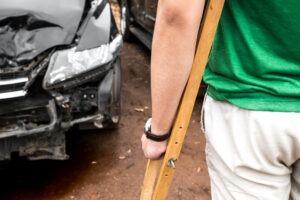 What to Do After a Car Accident in Arizona
What to Do After a Car Accident in Arizona